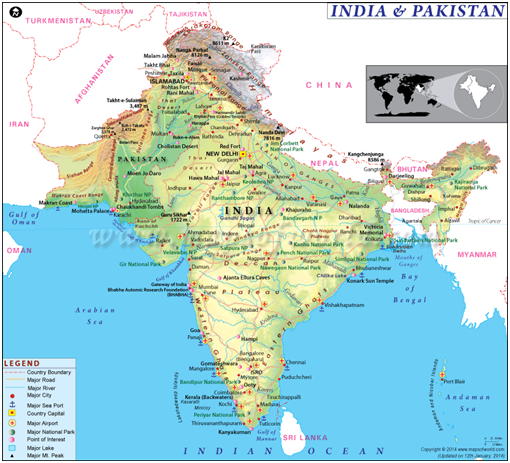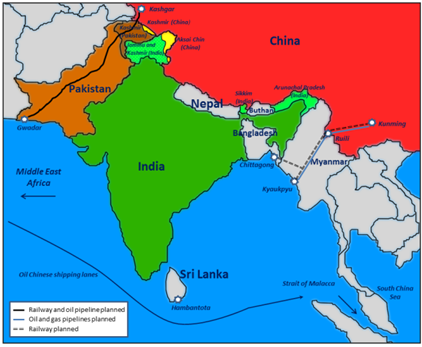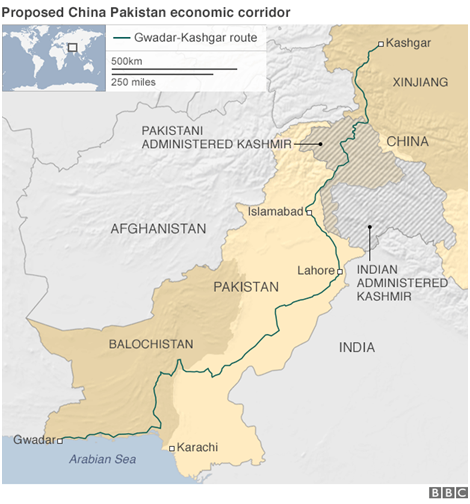India’s New Approach on Balochistan and POK - A New Paradigm
- In Foreign Policy
- 10:28 AM, Sep 04, 2016
- Dipankar Jha
PM Narendra Modi twice in August 2016 announced India’s support to Balochistan and intention of reclaiming POK (Pakistan Occupied Kashmir) from Pakistan. This is a well studied and planned move by the Indian Government. It is a change and a new direction to Indian foreign policy in engaging two difficult neighbors Pakistan and China. The subsequent acclamation almost immediately from Baloch separatists, Bangladesh and former president of Afghanistan, Dr. Hamid Karzai indicates that a lot of coordination has already taken place. It is also important to note two distinct events on world forum which indicate previous preparation behind this changed approach announced in public.
One such incident was the statement of UN on the role of UNMOGIP in Kashmir http://www.dnaindia.com/india/report-un-backtracks-on-unmogip-role-in-kashmir-says-limited-to-loc-2240657. The UN position was clarified by UN Secretary General Ban Ki-moon's spokesman Stephane Dujarric. Interestingly, when asked why he was making the clarification, Dujarric said “Because it needed to be said.” Why did Dujarric have to say this? The other important indication was from US where in a Statement, US State Department spokesperson expressed concern over human rights abuse in Balochistan. http://www.outlookindia.com/newswire/story/us-expresses-concern-over-rights-violations-in-balochistan/950043
The question that needs to be answered is why this shift in Indian policy to both POK and Balochistan simultaneously and why was all the background work undertaken. An answer lies in understanding how Pakistan, India and China look at their international roles and the underlying agendas of actions.
Pakistan:
Pakistan has been on an aggressive template with India (and indeed most of its neighbors) since its formation in 1947. Kashmir is just the present face of that template of aggression against India. How India views the Kashmiri unrest and how Pakistanis view the unrest are completely different. The Pakistani template borrows heavily from Islamic aggressors that invaded India successfully at the turn of the first millennium. A Pakistani idolizes Ghazni and Ghori also reflected in the names of their ballistic missile.
Ghazni and Ghori attacked India repeatedly. Ghazni specially took multiple years and raids to slowly chew inwards into India. http://www.facts-about-india.com/attacks-of-muhmud-of-ghazni.php and https://en.wikipedia.org/wiki/Mahmud_of_Ghazni
Ghori led up to 09 raids on Indian territories. Ghori too, did not give up after his failure at his first battle of Tarain. He came back and secured his objective after his first defeat. http://www.facts-about-india.com/attacks-of-muhammed-ghori.php and https://en.wikipedia.org/wiki/Muhammad_of_Ghor
Zulfikar Ali Bhutto’s speech in UN Security Council where he promised a war for 1000 years with India and then Gen Zia’s strategy of bleeding India through a 1000 cuts are inspired by the successful models of early Islamic invaders in India.
This is what Pakistan is trying. If somehow India nullifies Kashmir, Punjab may flare up again. If India is able to control Punjab - Hindu Muslim riots can be reignited. There are possibilities which may enable Pakistan to continue this undeclared war forever, without fear of failure or consequences of fighting a full-fledged war in a nuclear backdrop. Pakistanis have been at war with India since the day of their independence. India’s inability to stop them from doing so encourages Pakistan further, hoping for an eventual failure of the India state under sustained attack.
To sustain this campaign they use religious templates of 'Ghazwa -e- Hind' and the constant vilification of Hindus and India. The ordinary Pakistani is available for Jihad and the Army is justified in running Pakistan. The Elite of Pakistan have ensured perpetual rule over that country. Just like Ghazni they do not upset the World Powers (Caliphate) and are willing errand boys when the world powers need a help. Pakistan has chosen eternal enmity.

China:
The Chinese are a civilizational state like India and take a lot of pride in their past. The Chinese perceive it as their right to be a world power and have been working assiduously towards that goal. The buildup of military and economic might to rival the world’s utmost power – United States is a declaration of this intent. Under the absolute control of the Communist Party, the Chinese state has faced little opposition from within, in its stated ambition even if the buildup may lead to eventual catastrophe. The one party rule has also ensured continuity of long term plans unhindered. Over a long period Chinese view India as their civilization challenge in gaining absolute power.

Communist China has always viewed India as both a threat and competition. India’s success with democracy and hosting of Tibetan refugees including the Dalai Lama has always rankled China. This is further compounded by the boundary disputes created by China and expansionist territorial claims on Indian Territory by China. The 1962 aggression and sudden Chinese withdrawal also had lessons for China. Crossing the high plateau of Tibet and Himalayas and then waging a war on India in Indian Territory could be suicidal. The Chinese after 1962 went back to the drawing board. To strengthen their lines they developed their infrastructure but the short supply line of India to the Chinese border and smart positioning of Indian assets by the India military nullified substantially the advantages of their hard built logistics network quickly.
Additionally, China also faces the challenge of geography. Indo (South) China Sea is their only access to the sea route. To effectively counter India and to dominate the sea space both in the IOR and west of India towards the Suez and Mediterranean, China needs secure alternate and exclusive access to the ocean. No friendly country or port could provide this like Gwadar could. Through initial acquisition of Shaksgam valley in POK and subsequently the building of the Karakoram highway through POK, China has established more than a foot hold in POK. Chinese troops are deployed within POK to guard the highway. China also controls the nuclear energy and nuclear program of Pakistan which it helped create. The Ballistic missile program of Pakistan is also a Chinese gift via N. Korea. China supplies a lot of the Pakistani military hardware but ensures that it does not give away to Pakistan those weapons which would put China in the lethal range of Pakistanis.
Another step in this direction was the CPEC (China Pakistan Economic Corridor) corridor. An almost defunct Pakistani economy needed the Chinese support and China provided this through the CPEC program. What China gets in return is the exclusive and non-intrusive access to Gwadar (though it has never been said so) and a secure land route which the Pakistani Army will guard through fresh battalions raised under Chinese funding. In short a strategic access to the ocean and a land bridge all the way to Lop Nor. Any other justification for the port of Gwadar falls flat in the face when a deeper port like Karachi which is at 45% capacity utilization and all road infrastructure right up to Karakoram highway already exists from Karachi.

The Chinese through CPEC will effectively control Pakistan both militarily and economically. More worrying for India is to find the submarines of the PLAN (Peoples Liberation Army Navy) both on the Eastern Coast and Western Coast. With a submarine fleet of more than 54, China is effectively in a position to attack India from land – both on the east and west and from sea both on the east and west. The logistical challenges of ’62 would not be a hindrance any more.
India:
India forms its opinions and outlook as other nations based on its historic civilizational influences. India was a spiritual center with peace as its primary message through the Vedic Philosophy (Vasudev Kutumbhakam), extreme nonviolence of Jains and Buddha’s message of Ahimsa. The larger than life influence of M. K. Gandhi (Bapu) on all Indians of current day further makes the country a pacifist and an idealistic State in pursuit of the ideal image in the world. Our belief system also makes us look inwards and find our own faults instead of openly confronting an alien aggressor.
Despite, clear indications of conflict or signs of impending conflict India has hesitated militarily on all occasions except perhaps the ’71 war with Pakistan. The non military response towards aggressor state and military deployment in our own territory has till now saved us from disintegration but it has not deterred our enemies from attacking us. However, with China stepping in Pakistan through CPEC, we now face a situation where an enemy of superior military and economic might may attack us both from the East and West. It’s no longer a matter of fighting decisive battles at the borders and hope for peace for a decade or so. It calls for a new paradigm.
This is perhaps the primary reason for India to shift gear and move out of pacifism. A look at how we responded to Pakistan since 1947 will help understand the crucial role of our changed approach on Balochistan and POK better.
As Indians, our prism makes all Pakistani offensives which are less than declared war, an internal problem. We tend to think of conflict with Pakistan as four distinct wars which we either won or stopped the Pakistanis from achieving their objectives. For us 1948, 1965, 1971 and 1999 were the wars we fought against Pakistan and they lost. Kashmir is viewed as an internal unrest funded and funneled from Pakistan and not as a war by Pakistan. The Punjab crisis of the'80s was similarly viewed as an internal problem despite the vast interference from Pakistan.
By not taking the war across to Pakistan (and it may not be conventional war of armies), we are allowing Pakistan the freedom Ghazni and Ghori had. They were never worried about an Indian ruler attacking their kingdoms. They were always free to launch attacks on Indian rajahs, kingdoms and temples, just like PA / ISI (Pakistan Army/Inter-Services Intelligence) is being allowed to continue operations in India today. If this continues, the PA will continue attacking. We will continue blocking and neutralizing. We will need to win every time. They need to win once and that one victory will alter the entire future as it did at Battle of Terrain in 1192 especially after Pakistan became nuclear.
The arrival of PLA (Peoples Liberation Army) and PLAN make a strong case of that one elusive victory coming true. It is still only a possibility but it is definitely a strong case for India to act and cut off the threat before it builds. POK and Balochistan are the Alpha and Omega of this threat as POK lies at the head of the problem (PLA presence) and Balochistan lies at the tail of the problem (PLAN presence).
The recent claim on getting back POK and recognition of Balochistan issue is India's attempt at taking the war back into Pakistan and making it difficult for China to set up secure bases and routes for Strategic Access into Arabian Sea and westward.
Offensive – Defense
Balochistan
The future of Balochistan if India supports the Balochis with military aid can be either:
a) Secession from Pakistan after two to five years more of guerrilla war
b) A long drawn but sustained guerrilla war with no clear winners.
The advantages to India in case a) irrespective of whether independent Balochistan is friendly or not
- A diminished Pakistan with reduced resources and lesser Strategic Depth. The loss of Balochistan brings the farthest reaches of Pakistan closer to Indian attacking options.
- Loss of a hinterland for Pakistan where they conducted nuclear tests and housed foreign terror groups like Taliban (Mullah Omar and Mullah Akhtar)
- Major loss leading to crisis of confidence.
- Narrower access to sea and hence lesser relevance to their claim of Strategic location vis-a-vis Central Asia
- Loss of importance in eyes of both China and Western powers.
- The loss of strategic nature of CPEC even if China continues with the project. Nuclear fuel and weapons will not travel this route and hence it ties down China to South China sea for all Strategic activities.
The advantages to India in case of continued guerrilla war in Balochistan with Indian support
- Insurgency within Pakistan forcing it to divert resources and attention
- Pakistan Army (PA) redeployment to handle an intensified Baloch campaign
- War of attrition hurting the PA which so far remains mostly secure
- Core agenda of the ruling elite will be to retain Pakistani integrity and not dismember India
- India takes the fight to Pakistani soil
- The diversion in Balochistan enabling retaking POK
- Loss of freedom for movement of Chinese goods through Gwadar and ability to attack CPEC if an important consignment needs to be hit
- Availability of Baloch guerrillas to target military within Punjab and other secure places without Indian Army having to cross the borders.
Pakistan Occupied Kashmir (POK)
The change in position on POK is similarly aimed to either completely cut off or stymie the Chinese access to the coastline of Pakistan from the north. India needs to succeed in only one of the two places for CPEC to be effectively dead and the threat nullified.
Summary
The failure of the Indian establishment to view Pakistani offensive in Kashmir, Punjab and other terrorist attacks along with (Fake Indian Currency Notes) FICN, drug trade etc. as war was waged on India by other means has given Pakistan the opportunity to actually make mountains out of mole hills in India. India has been a sponge or a shock absorber to all Pakistani mal-intentions which has encouraged a greater and increased Pakistani aggression over the years. Pakistanis continue with impunity a war which is both economically viable and sustainable for a long period of time. They continue to search unhindered, for the one successful way to dismember India. With the increased presence and support of more capable military this threat is now more serious.
Taking the fight back into Pakistan is an important step in controlling Pakistan and taking consequences of aggression back into the enemy territory. It is also critical in stopping the Chinese dragon from truly engulfing India.







Comments